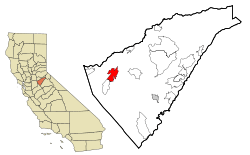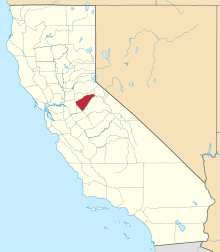Valley Springs, California
Valley Springs (formerly, Spring Valley and Valley Spring) is situated in the foothills of the Sierra Nevada Mountain Range and is a census-designated place (CDP) in Calaveras County, California, United States. Valley Springs is registered as a California Historical Landmark #251.[2]
Valley Springs | |
|---|---|
Census designated place | |
 New Hogan Lake, Valley Springs | |
 Location in Calaveras County and the state of California | |
 Valley Springs Location in the United States | |
| Coordinates: 38°11′30″N 120°49′45″W | |
| Country | |
| State | |
| County | Calaveras |
| Area | |
| • Total | 9.875 sq mi (25.579 km2) |
| • Land | 9.872 sq mi (25.570 km2) |
| • Water | 0.003 sq mi (0.009 km2) 0.04% |
| Elevation | 669 ft (204 m) |
| Population | |
| • Total | 3,553 |
| • Density | 360/sq mi (140/km2) |
| Time zone | UTC-8 (Pacific) |
| • Summer (DST) | UTC-7 (PDT) |
| ZIP codes | 95226, 95252 |
| Area code | 209 |
| FIPS code | 06-81890 |
| GNIS feature IDs | 1660090, 2409398 |
| Website | Official website |
| Reference no. | 251 |
History
Valley Springs was once known as Spring Valley. Because there was another post office called Spring Valley in Colusa County, the name was changed to Valley Springs. The earliest settlers were Native American. The presence of grinding rocks found in Valley Springs suggests that the Mi-Wuk, and the Yokut tribes, resided in Valley Springs. They gathered acorns for trade and food before returning to their home in the spring. The Mi-Wuk were later driven further into the hills due to Gold Rush miners.
1849 saw the first saloon and store in the Valley Springs region. Thereafter, small farms and large ranches were established to provide food for settlers. Stage stops emerged along (now)Highway 26, lodging developed, and (now)Highway 12 linked roads to the surrounding areas.
A need for more affordable freight rates, expansion of tourism to Big Trees, and timber interests caused a need for a quicker mode of transport. Land was being sold quickly, roads and buildings were being built as settlers settled in. The railways expanded and on April 25, 1885, the very first train pulled into Valley Springs station which was at first merely a tent. Valley Springs became a center of freight distribution. Furthermore, residents could reach San Francisco in seven and a half hours, Stockton in two and a half hours, Sacramento in three hours, and by train. A large fire burned down the majority of the central town in September 1895. Because of this fire, the lack of rail expansion to the nearby mountains, and due to the lofty expectations of the railroad, Valley Springs was hit hard.
Despite rebuilding the town, Valley Springs' population increase was below one percent a year. Not even the appearance of electricity in 1899 and the SP rail’s move to a standard gauge line would encourage local growth. From 1910 to 1930 the population drastically decreased. In 1923, Valley Springs only had 350 residents! However, 1925 saw a big change with the Calaveras Cement Company’s need for product transportation. The rail extended which helped develop the Pardee Dam as well as help in the shipment of cement directly to sources such as the Bay Area. The McClellan and Travis Air Force base, San Francisco Airport, the Central Valley Dams, and the San Francisco-Oakland Bay Bridge was built thanks to Valley Springs and the local cement it transported over the miles.
Calaveras Cement and the construction of both the Hogan Dam and Pardee Dam increased employment. Local lumber, forest products, cement, and clay resources increased shipping needs. Agriculture still remained the main occupation of residents whose primary agricultural focus was on grains, livestock, and small-scale wine grapes and olives. Nevertheless, Valley Spring’s strategic location was key to it importance.
1930s and 1940s saw a six percent annual population increase. Population then flattened out in the 1950s to increase again in the 1960s. This was largely due to the development of the Camanche Reservoir and the expansion of the Hogan Reservoir. The 1970s saw population increase resulting from Rancho Calaveras, the La Contenta Golf Course, and the development of its surrounding HOA governed homes. The doors of major manufacturing closed in the 1980s yet, Valley Springs continues to expand in population and development. For decades it assisted in the development of major cities in the valley and the bay. Now however, Valley Spring’s is developing its own community.[3]
[In 1885 the San Joaquin and Sierra Nevada Railroad completed a narrow-gauge railroad from Brack's Landing to Valley Springs. There was an old train station known as "Kokines station". The line eventually became the property of Southern Pacific Railroad, and a standard-gauge line into Valley Springs was substituted. A post office was opened there in 1872, closed in 1879, and re-established in 1882.[4]]
Geography
According to the United States Census Bureau, the CDP has a total area of 9.9 square miles (26 km2), 99.96% of it land.
Climate
| MONTH | Jan | Feb | Mar | Apr | May | Jun |
| Avg. High Fahrenheit | 53 | 59 | 63 | 69 | 79 | 88 |
| Avg. Low Fahrenheit | 39 | 42 | 44 | 47 | 52 | 57 |
| Av. precipitation in inch: | 4.13 | 3.86 | 3.82 | 2.01 | 1.18 | 0.28 |
| MONTH | Jul | Aug | Sep | Oct | Nov | Dec |
| Avg. High Fahrenheit | 94 | 93 | 88 | 77 | 62 | 53 |
| Avg. Low Fahrenheit | 62 | 62 | 59 | 53 | 45 | 39 |
| Av. precipitation in inch: | 0 | 0.04 | 0.43 | 1.3 | 2.68 | 3.74 |
Summers are typically very warm to hot, springs and falls are temperate, and winters are cool with a slight dusting of snow and/or frost. Hot, dry summers make Valley Springs fire-prone; however, there are three fire stations, lake water, and adequate road access in order to assist in extinguishing fires expediently.[6]
Demographics
| Valley Springs total population | |
| Population | 3,553 |
| Male Population: | 1,759 |
| Female Population: | 1,794 |
Politics
| Voters | Valley Springs | United States |
|---|---|---|
| Republican | 57.4% | 45.9% |
| Democrats | 33.8% | 48.0% |
| Independent | 8.8% | 6.0% |
Valley Springs voters are a majority Republican, approximately one third Democrat, and approximately 9% Independent. This is a greater percentage Republican and Independent than the United States average, and a lesser percentage Democrat.[8]
In the state legislature, Valley Springs is in the 8th Senate District, represented by Republican Andreas Borgeas,[9] and the 5th Assembly District, represented by Republican Frank Bigelow.[10] Federally, Valley Springs is in California's 4th congressional district, represented by Republican Tom McClintock.[11]
References
- "2010 Census U.S. Gazetteer Files – Places – California". United States Census Bureau.
- "Valley Springs". Office of Historic Preservation, California State Parks. Retrieved 2012-10-06.
- "THE HISTORY OF VALLEY SPRINGS | westcalaverashistory.org". www.westcalaverashistory.org. Retrieved 2019-06-30.
- Durham, David L. (1998). California's Geographic Names: A Gazetteer of Historic and Modern Names of the State. Clovis, Calif.: Word Dancer Press. p. 841. ISBN 1-884995-14-4.
- "Climate Valley Springs - California and Weather averages Valley Springs". www.usclimatedata.com. Retrieved 2019-07-01.
- "Valley Springs, CA Fire Departments". FireDepartment.net. Retrieved 2019-07-01.
- "Current Valley Springs, California Population, Demographics and stats in 2019, 2018". Population and demographics information. Suburban Stats, Inc. Retrieved 1 July 2019.
- "2019 Compare Cities Politics & Voting: Valley Springs, CA vs Linden, CA". https://www.bestplaces.net. Retrieved 2019-07-01. External link in
|website=(help) - "Senators". State of California. Retrieved March 21, 2013.
- "Members Assembly". State of California. Retrieved March 21, 2013.
- "California's 4th Congressional District - Representatives & District Map". Civic Impulse, LLC. Retrieved March 2, 2013.
